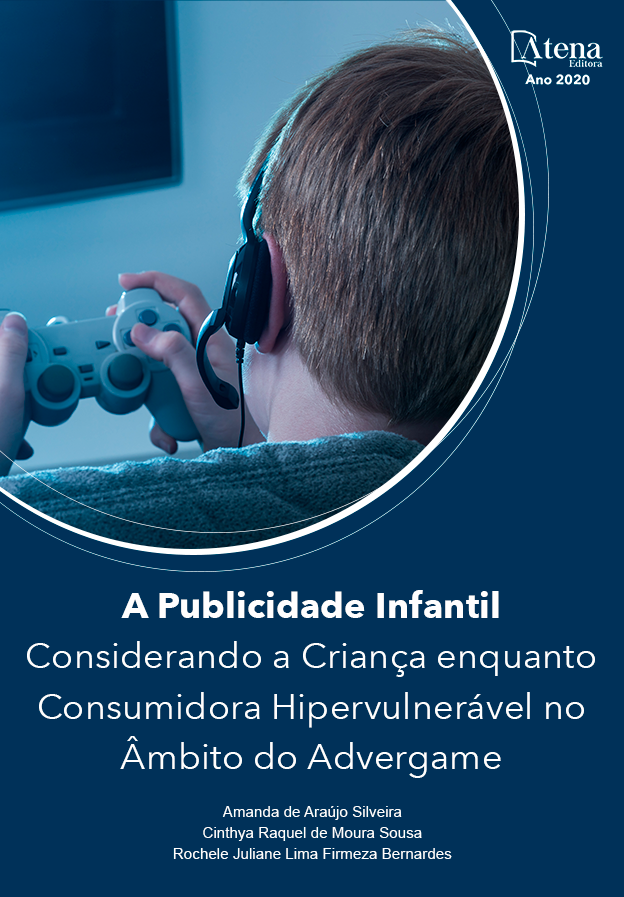
A PUBLICIDADE INFANTIL CONSIDERANDO A CRIANÇA ENQUANTO CONSUMIDORA HIPERVULNERÁVEL NO ÂMBITO DO ADVERGAME
Atualmente, a sociedade, por conta da popularização da internet e dos avanços tecnológicos, tornou-se uma “aldeia” global. Nesse contexto, o consumo se tornou o motor da sociedade em que o sujeito, agora, indivíduo-consumidor, adquire objetos apenas para satisfazer desejos inconscientes. Nesse ínterim, o mercado publicitário passou a cortejar crianças e adolescentes, sujeitos em desenvolvimento físico e mental, hábeis manipuladores da tecnologia e afeitos a novidades, colocando-os como protagonistas do mercado de consumo. Esse setor aliou tecnologia, publicidade e entretenimento para atingir as crianças de maneira mais eficaz, utilizando-se de diversas ferramentas tecnológicas, sendo uma delas, o advergame, uma estratégia publicitária que divulga determinada marca dentro de jogos eletrônicos. Diante do exposto, buscou-se imprimir um olhar problematizador para a publicidade infantil, em especial, no âmbito do advergame. Assim, a fim de sanar a questão-problema, a pesquisa é de natureza qualitativa de cunho bibliográfico. Diante das análises feitas, constatou-se que, no que tange à publicidade infantil, ela é proibida por meio da interpretação sistemática do Código Brasileiro de Autorregulamentação Publicitária, do Código de Defesa do Consumidor, entre outras legislações. Entretanto, tais legislações são genéricas e não tratam da publicidade infantil nas novas mídias digitais, como o advergame. Quanto a análise jurisprudencial, observou-se que, os tribunais obedecem as regras impostas pelo ordenamento jurídico consumerista, assim como as outras normas apresentadas, visando a proteção da infância. No que diz respeito aos impactos gerado pela publicidade infantil, ela traz impactos negativos como, por exemplo, materialismo, erotização, estresse familiar, transtornos alimentares, entre outros, todos com consequências maléficas para o desenvolvimento desse grupo. Por fim, a Constituição, no art. 227, traz o dever de proteção integral à tríade: Estado, família e sociedade civil. Isto posto, conclui-se que, o mercado publicitário deve respeitar a legislação vigente e assumir uma postura ética e responsável, não se aproveitando da deficiência de discernimento desse grupo, hipervulnerável.
A PUBLICIDADE INFANTIL CONSIDERANDO A CRIANÇA ENQUANTO CONSUMIDORA HIPERVULNERÁVEL NO ÂMBITO DO ADVERGAME
-
DOI: 10.22533/at.ed.362200112
-
Palavras-chave: Publicidade Infantil. Criança. Consumidora Hipervulnerável. Advergame. Regulamentações.
-
Keywords: Children’s Advertising. Kids. Hypervulnerable consumer. Advergame. Regulations.
-
Abstract:
Currently, society became a big “village” due to the popularization of the internet and technological advances. Taking this context into consideration, consumption became society’s fuel in which each individual, now individual consumer, that buy objects just to satisfy their unconscious desires. Besides, the advertising market began to target children and teenagers, subjects that are still developing physically and mentally, but master technology in general, making them protagonists of the consumption market. This industry put together entertainment, publicity, and technology to reach kids more effectively, using tons of technological tools. One of them is advergame, an advertising strategy that announces products from brandings inside electronic games. Whereupon, a problematizing sight was launched into children’s advertising, especially in advergame’s field. Trying to solve this problem, the research presented here belongs to a qualitative bibliographical nature. Due to these analyses, it was stated that children’s advertising is forbidden as concerns the Brazilian Code of Advertising Self-regulation, from the Consumer Protection Code, and other regulations. However, these laws are generic and do not address children’s advertising in new digital media, such as advergame. Regarding jurisprudential analysis, it was noticed that courts follow rules imposed by the consumer legal system and the other standards presented, aiming at protecting childhood. As for the impacts children’s advertising has, it was listed a few: materialism, sexualization, familiar stress, eating disorders, among others. All of them have negative consequences in this group’s development. Finally, the Constitution in article 227 places the duty of protection to the triad: State, family, and civil society. Therefore, it was concluded that the advertising market must respect the current regulations and take an ethical and responsible attitude. They should not continue to take advantage of the lack of impairment of this group, hyper vulnerable.
-
Número de páginas: 86
- Cinthya Raquel de Moura Sousa
- Rochele Juliane Lima Firmeza Bernardes
- Amanda de Araújo Silveira


